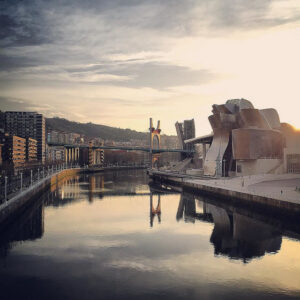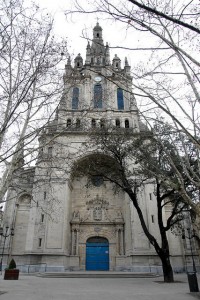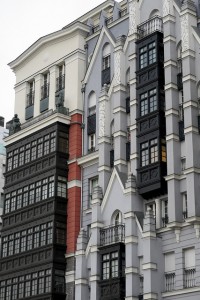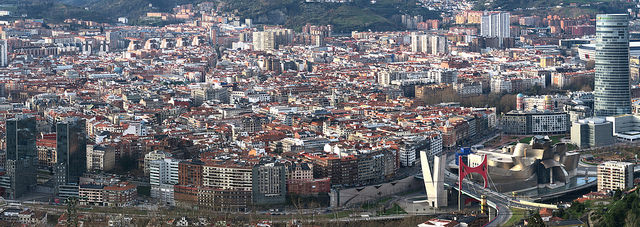A short break to escape the Christmas-fever. Going to a Spanish island – sure of sun and warmth, or a city trip? Nature or culture. Very expensive or rather cheap. The second of all possibilities …
Bilbao is the capital of the Basque country, Northern Spain. It is a rather small capital, with about 300,000 citizens. An industrial and fishing history, and – sadly – a bloody history. ETA used to commit terrorist attacks to gain independence from Spain. All is calm since a few years, nothing much reminds an unknown tourist of the past (neither economical nor political).
 We flew with Vueling, the Spanish low-cost airliner, from Brussels to Bilbao, which is only about 2 hours. The airport itself is about 15 minutes by bus from the city center. However, it could take you much longer to wait for that bus with only one bus per 25 minutes… If you’re the last in the line, and a few airplanes just landed, you can wait for a long time! But it is the cheapest way to get to the center, it only costs € 1,45 per person (single). The first eyecather is the Guggenheim museum. Built by Frank Gehry to turn Bilbao in a modern city in the 1990’s.
We flew with Vueling, the Spanish low-cost airliner, from Brussels to Bilbao, which is only about 2 hours. The airport itself is about 15 minutes by bus from the city center. However, it could take you much longer to wait for that bus with only one bus per 25 minutes… If you’re the last in the line, and a few airplanes just landed, you can wait for a long time! But it is the cheapest way to get to the center, it only costs € 1,45 per person (single). The first eyecather is the Guggenheim museum. Built by Frank Gehry to turn Bilbao in a modern city in the 1990’s.
The result is a contemporary building, made of glass and titanium, which can easily be a pain in the travelbudget … € 13 per person is an expensive museum ticket! Especially when a lot of the art works are just outside. Puppy is watching the surroundings, a giant spider (Maman) freaks out us arachnafobia’s, the fog and lightspectacle (Fog Sculpture and Fire Fountain) are around the corner, and the Tulips can be seen from the bridge and the promenade at the water. On the Puente de la Salve (from where you drive down towards the city) the red arch is a piece of art built to celebrate the 10th anniversary of the Guggenheim. The bridge itself was already built in the 70’s.
From the museum it is a lovely walk to the old part of town, along the river. However, to save our legs, we took the tram, which is about 5 minutes to the Ribera Market (costs € 1,5 per person single). Sadly, the market was already closing when we arrived. A small reminder of the Spanish culture: everything closes around 2pm, to open again from 5pm. Eating lunch is possible between 1pm and 4pm, dinner usually starts around 8pm. Bummer if you’re hungry and don’t feel like having pintxos (tapas) …
The old town has lots of small streets, filled with pintxos bars (where people eat and drink outside). Some nice sites include the Catedral de Santiago where pilgrims on the Santiago de Compostella route take a break, the Plaza Nueva – a big square with bars and the very lovely Teatro Arriaga. But just as interesting are  the old houses with there ancient façades! All these buildings breath history (the cathedral is more than 500 years old, unfortunately closed when we where there), and are a treasure for architecture lovers (think neo classical – Plaza Nueva, neo baroc – Teatro Arriaga, art deco – Ribera Market). For a nice view head towards the Basílica de Begoña, but turn off at the cemetery (Campos de Mallona).
the old houses with there ancient façades! All these buildings breath history (the cathedral is more than 500 years old, unfortunately closed when we where there), and are a treasure for architecture lovers (think neo classical – Plaza Nueva, neo baroc – Teatro Arriaga, art deco – Ribera Market). For a nice view head towards the Basílica de Begoña, but turn off at the cemetery (Campos de Mallona).
The Basílica is seen from far away, but buildings around it block the view over the city. The park (Parque Etxebarria) at the turn off however is a good place to see it all beneath you. If you don’t want to turn back on your steps, you can just follow the path and go down towards the river.
The second day we wanted to spend some time up high. We walked along the river to the Zubi Zuri Bridge. A very modern and arty bridge, which leads to (or goes away from) the Izozaki Towers. It was the architect’s intention to recreate a city gate on the place where, in the early 1900’s, goods were traded. The steps between the bridge and the towers have to remind you of the Spanish Steps in Rome. From the bridge it is only a small walk to the funicular station. The funicular celebrated its 100th birthday this year. It was built in 1915 to connect the Artxanda suburb with the city center. A ride with the tram (see the hyperlapse here) is quite cheap (only € 0,95 per person, single) and the view over the city is very nice. You can even see the sea from here! Bilbao is basically cramped between the sea and the mountains, which is best seen from a birds-eye perspective. The sculpture of a fingerprint is a reminder of the Spanish civil war, not that long ago…
Once down, we walked to the metro station to head to Portugalete, a suburb about 20 minutes away. This too is not so expensive, and well worth the money (€ 1,70 per person, single – if you’re not planning to take more than 2 metro rides, just buy a return ticket instead of a day ticket). In Portugalete, we wanted to see the Vizcaya Bridge, which is World Heritage listed. We’ve never seen a bridge like this. It is incredibly high, and it is not a traditional bridge … A gondola takes people and cars back and forth crossing the river. It was the first bridge in the world to be constructed like this (late 19th Century!) to give the big ships their way to enter Bilbao. The colour in rusty red must remind you of the industrial past of the city. It is possible to walk across the bridge, on the arch, but at a ridiculous price of € 7 per person, while crossing the bridge floating over the water only costs € 0,35 … The view must be amazing, but when you walk to the basílica, there is almost just as much to see. The salty sea-air and the sunshine did there work … We were exhausted at night!
On our last day we stayed around the hotel. We slept in the area Ensanche, right across the Guggenheim. One of the youngest bridges (there are many!) of Bilbao is the Pedro Arrupe Footbridge, not too far from  the museum. With a lot of imagination you should recognize a dragonfly in the bridge … Crossing the bridge brings you straight to the university. A couple of nice buildings! We walked along the other side of the river, back towards the older part of the city. It is a lovely promenade, with many beautiful buildings and good opportunities for people watching 😉 It’s not difficult to get back to Ensanche, just cross any bridge and walk straight forward.
the museum. With a lot of imagination you should recognize a dragonfly in the bridge … Crossing the bridge brings you straight to the university. A couple of nice buildings! We walked along the other side of the river, back towards the older part of the city. It is a lovely promenade, with many beautiful buildings and good opportunities for people watching 😉 It’s not difficult to get back to Ensanche, just cross any bridge and walk straight forward.
A must-see is the Alhóndiga building or the Azkuna Zentroa. This used to be an old wine warehouse, now it is some sort of cultural gathering place, with a library and an exposition hall. The pillars inside the building are pretty cool, but the eye-catcher and the reason why you should come here is most definitely the swimming pool! Not to get wet, but to look at the swimmers from a different position. The bottom of the pool is transparent … A nice place to rest is the Parque de Doña Casilda Iturrizar, or the Parque República de Abando. They both are just a few meters away from the Plaza del Museo. Should you need a bit more culture, the Museo de Bellas Artes is a good tip.
A three-day trip is perfect to see everything there is on a pleasant stroll. We were a bit disappointed by the way people look at tourists though, Bilbaons are not the friendliest of all people … This is a city that tries to get on the map, and has some nice sightings. But we feel the work isn’t done yet.
